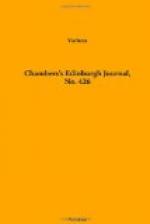RECENT FIRE-PANICS.
The panic created by a cry of fire in theatres, churches, and other public buildings, may be said to cause a considerably greater number of deaths than the flames themselves. Few persons, indeed, are burnt to death, means of escape from conflagration being usually found; whereas, the number suffocated and bruised to death by mere panic, is lamentably large. The following is the account of a most disastrous fire-panic, which we gather from a paper in an American Journal of Education.
In the city of New York there is a school, known as the ’Ninth Ward School-house,’ Greenwich Avenue. The house is built of brick, and consists of several floors, access to which is obtained by a spiral staircase. The bottom of the staircase is paved with stone, and ten feet square in extent. Standing in the centre of this landing-place, we look up a circular well, as it may be called, round which the stair winds with its balustrade. The school is attended by boys and girls, in different departments, under their respective teachers. It was in this extensive establishment, numbering at the time 1233 boys and 600 girls, that the panic occurred, and it broke out in a singular and unexpected way.
One day last December, Miss Harrison, a teacher in the female department, who had been for some days indisposed, was suddenly, and while performing her duties in the school, seized with a paralysis of the tongue. The spectacle of their teacher in this distressing condition, naturally suggested to the children that she was faint, and required water. At all events, the word water was uttered. It was repeated. It became a cry; and the cry excited the idea of fire. A notion sprang up that the school was on fire. That was enough. The floor was in an uproar; and the noise so created in one department was communicated to the others. The whole school was seized with panic! Now commenced a rush towards the various doors. Out of each poured a flood of children, dashing wildly to the staircase. The torrent jammed up, and unable to find outlet by the stair, burst the balustrades, and down like a cataract poured the maddened throng into the central well, falling on the paved lobby beneath. The scene was appalling. ’Before the current could be arrested, the well was filled with the bodies of children to the depth of about eight feet. At this juncture, the alarm reached the Ninth Ward Station-house, the fire-bell was rung, and a detachment of the police hurried to the scene. Here a new difficulty presented itself. The afternoon session of the school having commenced, the main outer-doors, which open upon the foot of the stairs, had been closed. Against these the affrighted children were wedged in masses, and as the doors open inward, it was some time before relief could be given them. The police fortunately effected an entrance by a rear-door, but for which timely help, many more of the children would probably have been suffocated.




